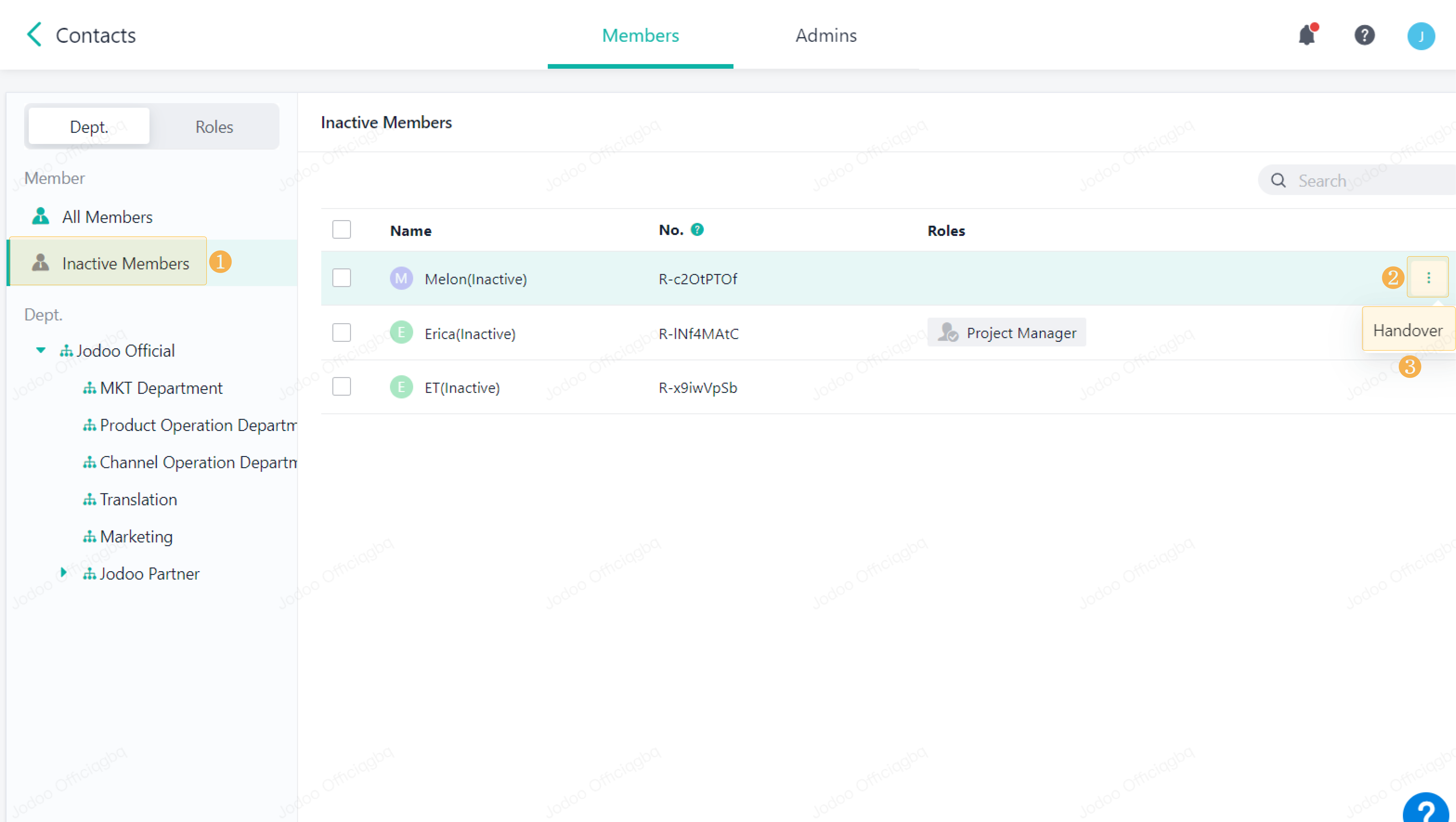Inactive Member Management
Introduction
Feature(s)
Hand over the work of the members who are inactive or going to be inactive in Jodoo to other approvers.
Application Scenario(s)
The following data can be handed over after members are inactive:
- Tasks
- Roles
- Workflow Approver
- Forms/Dashboards
Preview
Setting Procedure
The super admin and the owner can check and hand over the work of all members and inactive members in Contacts.
Handover
Check and hand over the work of members who are inactive and going to be inactive to others.
1. Members who are going to be inactive.
You can directly hand over the work in Contacts > Members > All Members. Select the member whose work is going to be handed over and click the button > Handover.
Select the corresponding work to hand over. The work and permissions that can be handed over include:
- Tasks
- Roles
- Workflow Approver
- Forms/Dashboards
After finishing all settings, click Complete.
2. Members who are inactive.
Hand over the work in Contacts > Members > Inactive Members.
The work and permissions that can be handed over are the same as those of members who are going to be inactive.
Managing Inactive Members
Inactive members cannot be deleted, so you can only deactivate them.
You can deactivate members after handing over their work (you can also hand over work after members are inactive). Members who have been deactivated will be in the Inactive Members list.
Note:
1. If you deactivate a member who is invited to a company/team but has not joined yet, the member will not be included in the Inactive Members list.
2. If you accidentally deactivate a member, you can also re-activate the member. For details, see Reactivating Inactive Members.
Deleting Inactive Members Permanently
If you are sure that some members will not be hired again, you can delete them permanently in Inactive Members.
After they are deleted permanently, the record will be displayed as Deleted Member. The following shows the difference between members who are deleted permanently and members who are not.
Note:
Think twice before deleting inactive members. Once you do so, you cannot restore their previous permissions by reactivating inactive members. When members are deleted, data related to them will be display as Deleted Member instead of their names.
Filtering Inactive Members
On PC
You can filter inactive members in the following scenarios:
- In the permission sets of forms/dashboards. The supported field types are Member, Members, and Created User.
- In Manage Data. The supported field types are Member, Members, and Created User.
- Filtered conditions in Recently Deleted.
- Filtering components in dashboards.
- Filter in Workflow Center. (My Tasks, Initiated, Processed, and CC me)
Click Filter, input the inactive member's name in the Search box, and click the button.
Click the button to filter active members.
On Mobile
You can filter inactive members on mobile in the following scenarios:
- In the permission sets of forms/dashboards. The supported field types are Member, Members, and Created User.
- Filter in dashboards.
- Filter in Workflow Center. (My Tasks, Initiated, Processed, and CC me)
Click Filter, input the inactive member's name in the Search box, and click the button.
Notes
Rule(s) for Deactivating Member
1. The search result may not be displayed if there are too many inactive members.
Note:
Super admins or the owner can delete inactive members permanently in Contacts. For details about ways of deletion, see the settings above.
2. If you accidentally deactivate a member, you can reactivate the member. For details, see Reactivating Inactive Member.
3. Think twice before deleting inactive members. Once you do so, you cannot restore their previous permissions by reactivating inactive members.
4. Admins can only be deactivated by the business owner or other admins. They cannot deactivate themselves.
5. You cannot deactivate the business owner. If you need to appoint a new one, update the email/mobile number linked to the owner account.
Rule(s) for Handing Over Child Workflow
If a child workflow node fails to flow to the next one because the flow rule (Proceed to the Next Node When) is violated or the next approver does not exist, super admins cannot hand over the tasks at the node to others.














